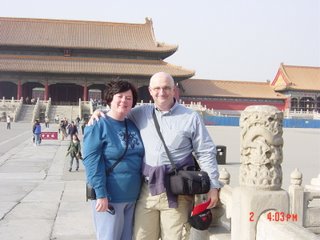Sunday, April 2, 2006, 7:51 p.m.
Less than one day until we get Cao Ai HuaBy Terry R. CassreinoBEIJING - Aisin-Gioro Pu Yi began his brief reign as emperor of China in 1905 when he was 3, ruling over his vast empire from behind the walls of the Forbidden City.
He abdicated the throne in 1912 at age 7, but stayed imprisoned in the Forbidden City until 1924 while living a life of luxury.

And on Sunday, Pam and I visited this massive landmark.
At once intimidating and jaw dropping, this 180-acre enclosed area in the heart if Beijing served as the seat of power for 24 emperors and two dynasties that ruled the Middle Kingdom.
Today, much of the Forbidden City sits in decay. Paint flakes from the walls; intricately colored fabric that adorns the walls and ceilings are torn and have faded with age.
Luckily, the Chinese government has come to its rescue with a lengthy, detailed restoration project that will have at least the Great Hall - where Pu Yi once ruled - ready by 2008.
The timing is perfect: Beijing will host the 2008 Summer Olympics and expects throngs of tourists to visit an already jam-packed city.
Repair workBut despite the obvious need for repairs, this historic monument remains an impressive attraction. If you have any doubt about that, then consider the following facts:

- The third emperor of the Ming Dynasty, Yongle, oversaw 200,000 people build the Forbidden City in just 14 years.
- The complex has 9,999 rooms - one short of the 10,000 rooms in Heaven. Nine, by the way, is a lucky number for the Chinese.
- All of the buildings were made of wood. Giant cauldrons held water throughout the complex in case of a fire.
- A total of 9,000 people, including eunuchs, servants and the emperor’s concubine, lived in the city at the end of the 18th century.
On Sunday, workers were every where. They were busy restoring the Grand Hall to its original look. And they were busy replacing the cobblestones that fill the vast courtyard.
Memorable tourOur tour group entered the Forbidden City from the north entrance and worked to the south, or main gate.
We viewed bedrooms and meeting rooms furnished with artifacts dating hundreds of

years. And we admired the intricate artwork that adorns the classical Chinese architecture.
And I thought back to the Oscar-wining film by Italian director Bernardo Bertolucci. “The Last Emperor” was the first film allowed to shoot inside the Forbidden City.
I remember sitting in the darkened theater at the Northpark Mall Cinema in Ridgeland in February 1988 watching the film and awestruck by the beauty I saw.
Those thoughts rushed back to me today as Pam and I stood in the courtyard and gazed in the rooms of one of the most historic places in Asian and Chinese history.
Oh, as for Pu Yi, he eventually found his way back to life as a peasant - working as an obscure gardener at the Botanical Gardens of Peking before he died.
Text and photos copyright 2006 by Terry R. Cassreino.







